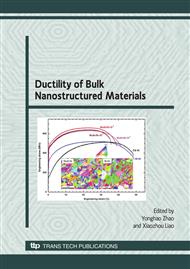p.231
p.249
p.263
p.273
p.303
p.311
p.321
p.333
p.341
Effect of Ageing on Strength and Ductility of Ultrafine Grained Al 6061 Alloy
Abstract:
An effect of ageing on mechanical properties of ultrafine grained Al 6061 alloys has been investigated in the present work. The solution treated bulk Al 6061 alloy was subjected to cryorolling to produce ultrafine grain structures and subsequently ageing treatment to improve its both strength and ductility. The hardness and tensile properties of solution treated, cryorolled, cryorolled and aged Al alloys were measured and explained by using their corresponding microstructural morphologies. The pre-cryorolled solid solution treatment combined with post-CR ageing treatment (1300C-30h) has been found to be the optimum processing condition to obtain the ultrafine grained microstructure with improved tensile strength (362MPa) and good tensile ductility (10.7%) in the Al 6061 alloy. The combined effect of precipitation hardening and recovery are responsible for the simultaneous improvement of both strength and ductility observed in the present work.
Info:
Periodical:
Pages:
303-309
Citation:
Online since:
November 2009
Authors:
Price:
Сopyright:
© 2010 Trans Tech Publications Ltd. All Rights Reserved
Share:
Citation:


